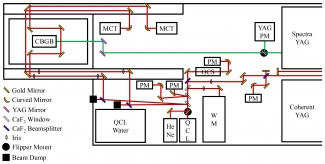Schematic of the laser optics setup, with the ablation laser in green and the IR laser in red. After origination in the QCL, a small portion of the IR beam is sent towards the CBGB system for the spectroscopic measurements, and the rest of the IR beam is sent to diagnostics to analyze the laser frequency.
Generally speaking, mid-infrared (mid-IR) light consists of electromagnetic radiation with wavelengths ranging from ~2.5 – 20 µm (~500 – 4,000 cm-1), and it induces molecular vibrational motion. Therefore, once we have produced the Cryogenic Buffer-Gas Beam, we use an infrared Quantum Cascade Laser (QCL) to probe the vibrational spectra of these cold clusters. Molecular vibrational frequencies are governed by the strengths of the bonds between the atoms. By studying vibrational spectroscopy, we can learn about the structure and bonding of these types of clusters, leading to a better understanding of how they form and how they can be used for future technology (such as designing new catalysts). Upon collection of a vibrational spectrum, the experimental results are then compared against theoretical predictions, using quantum mechanical calculations. Ideally, this comparison leads to greater insights about the nature of the structure and bonding of these clusters, as well as improving the theory for future calculations.



 The Physics Frontiers Centers (PFC) program supports university-based centers and institutes where the collective efforts of a larger group of individuals can enable transformational advances in the most promising research areas. The program is designed to foster major breakthroughs at the intellectual frontiers of physics by providing needed resources such as combinations of talents, skills, disciplines, and/or specialized infrastructure, not usually available to individual investigators or small groups, in an environment in which the collective efforts of the larger group can be shown to be seminal to promoting significant progress in the science and the education of students. PFCs also include creative, substantive activities aimed at enhancing education, broadening participation of traditionally underrepresented groups, and outreach to the scientific community and general public.
The Physics Frontiers Centers (PFC) program supports university-based centers and institutes where the collective efforts of a larger group of individuals can enable transformational advances in the most promising research areas. The program is designed to foster major breakthroughs at the intellectual frontiers of physics by providing needed resources such as combinations of talents, skills, disciplines, and/or specialized infrastructure, not usually available to individual investigators or small groups, in an environment in which the collective efforts of the larger group can be shown to be seminal to promoting significant progress in the science and the education of students. PFCs also include creative, substantive activities aimed at enhancing education, broadening participation of traditionally underrepresented groups, and outreach to the scientific community and general public.